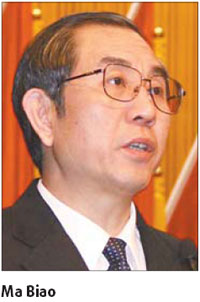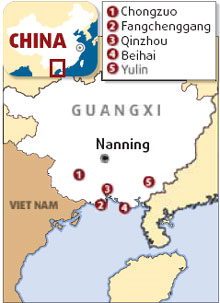'Moderate' outlook for southwest powerhouse
Updated: 2008-01-21 07:31
NANNING: Guangxi is set to become an engine of growth for Southwest China with the central government's endorsement of an economic zone last week, but the region will develop at a "moderate" pace this year, officials have said.
|
Delegates attend yesterday's first session of the annual Guangxi People's Congress. Huo Yan |
Excited at the opportunities presented by the State Council's approval of the Beibu Gulf Economic Zone development strategy, Ma Biao, acting chairman of the Guangxi Zhuang Autonomous Region, said the region will start up a new round of development and construction.
At the same time, Ma said the region's gross domestic product (GDP) is set to expand by 11 percent this year, nearly 4 percentage points lower than the estimated level for last year's figure.
"On the precondition of optimizing economic structure, improving benefits, lowering consumption and protecting the environment, we expect the region's GDP growth to expand by 11 percent, with per unit GDP energy use down by 3.5 percent," Ma told the Guangxi people's congress, which convened its annual session on Saturday. The meeting will last till Sunday.
"We can never pursue development at the cost of the ecology and environment," he said.

The Beibu Gulf strategy integrates the regional capital Nanning with five cities around the gulf - Beihai, Qinzhou, Fangchenggang, Chongzuo and Yulin.
The zone covers about a third of the region's area, which stretches 236,700 sq km, and contains 42 percent of Guangxi's total population, which reached 49.61 million at the end of 2006.
Under the new development strategy, Guangxi will develop the zone into a base for coastal industries and for cooperative ventures in logistics, commerce and trade, as well as in information exchange, between China and the Association of Southeast Asian Nations (ASEAN).
In addition to becoming a platform for economic exchange with ASEAN members, the zone is expected to become another engine fueling domestic growth, following the Pearl River Delta in the south, the Yangtze River Delta in the east and the Bohai Sea Rim area in the north.
Ma said Guangxi will open up further to ASEAN members, Japan, South Korea, Europe and the United States, as well as the Hong Kong and Macao special administrative regions and Taiwan.
He said the region will speed up infrastructure construction and develop the economy by striking a balance between investment, consumption and export.
Asked if petrochemicals, paper pulp manufacturing and other heavy industries in the zone would threaten the environment, Guo Shengkun, Party secretary of the region, said the industries in the zone had been distributed on a "scientific basis".
"What we are pursuing is development in a sound and rapid fashion," Guo told China Daily.
"We have mandated adequate environmental impact assessment and other scientific data to ensure development will not mess up environment."

Liang Bin, director of Guangxi environmental protection bureau said the seemingly lower GDP growth rate indicated that the region was trying to reconcile development with energy conservation and environmental protection.
"Apart from keeping pace with national development, the 11 percent rate of Guangxi is also based on calculations to ensure the region can meet its energy-saving and pollution reduction targets," he told China Daily.
Wen Ming, a top official of the Yulin municipality, said the city used to welcome foreign funds indiscriminately. Now it chooses only those that will fund plants that do not pollute the air, water or otherwise ruin the environment in what he described as one of the top tourist attractions in Guangxi.
For example, Yulin has just approved investment that helps transform its ceramic plants from a reliance on dirty coal to gas and electricity, he said.
Lian Younong, mayor of Beihai, said that as part of the Beibu Gulf Economic Zone, Beihai will continue to keep printing and dyeing, fireworks and fish meal plants at bay, while vigorously developing information technology and tourism.
A bio-fuel plant, capable of producing 200,000 tons of ethanol a year, has just been put into operation. It will expand its capacity this year, Lian said.
|
|
|
||
|
||
|
|
|
|
